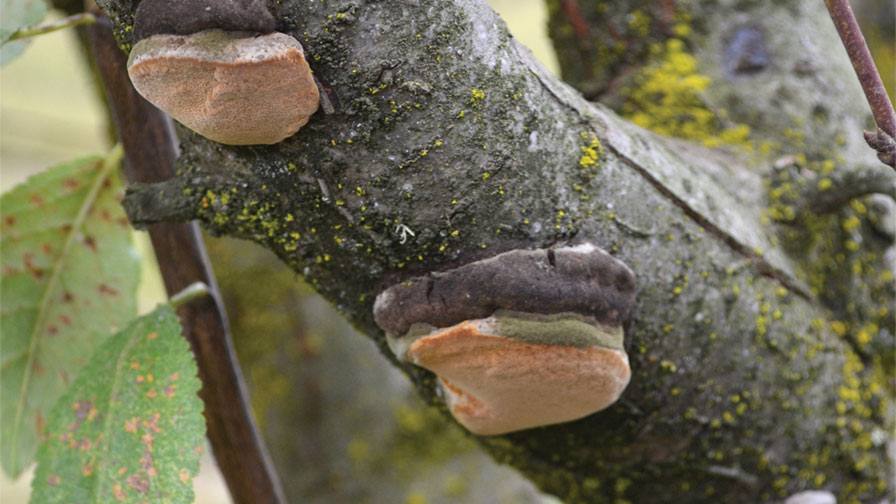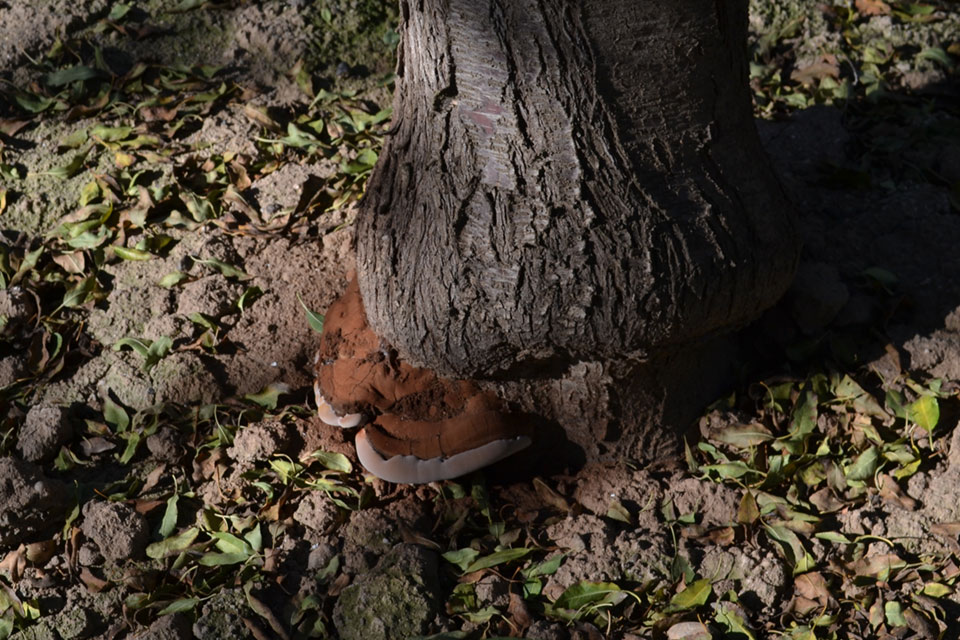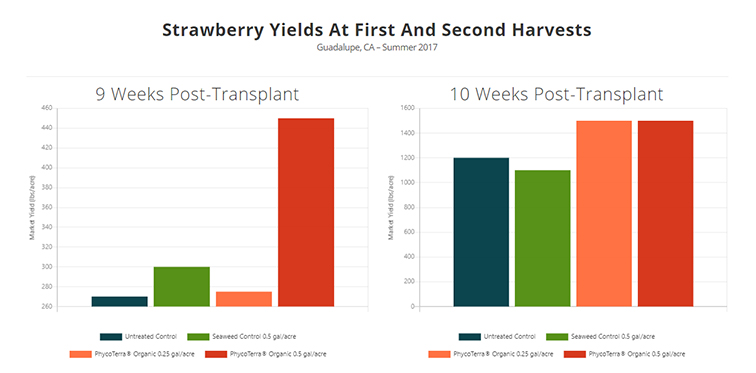Foreboding Fungus Vexes Almond Growers

Phellinus tuberculosus conk, growing in the scaffolds of a prune tree. (Photo Credit: Bob Johnson)
In parts of California, almond growers have recently become concerned about Ganoderma root and butt rot. To put this concern in context, it becomes necessary to understand wood decay fungi in general and how wood decay affects orchards.
Wood decay fungi are present wherever there are trees and may be recognized by mushrooms and conks (shelf mushroom). They form on trees, downed logs, and other woody debris. Most species of wood decay fungi are non-aggressive and opportunistically colonize and decay dead wood. These species pose little threat to the overall productivity and longevity of almond orchards.
However, some species of wood decay fungi can be extremely damaging to orchard crops. These fall into three general categories based on the type of damage they cause and the portion of the tree they infect: Armillaria root rot, heart rots, and butt rots.
A Look at Root and Heart Rot
Root rot caused by Armillaria mellea, also known as oak root fungus, survives on dead wood in the soil. The pathogen spreads from tree to tree when healthy roots come into contact with infected roots or other dead wood, resulting in characteristic disease centers. Armillaria initially infects the cambium (just under the bark) of the tree first, eventually girdling the tree at the crown. The pathogen will then continue to decay the wood of the roots. Armillaria is the most studied of the orchard wood decay fungi, and additional information and management strategies can be found at the University of California IPM website.

Active Ganoderma adspersum conk, notice bright white edge and reddish spores covering top surface. (Photo Credit: Bob Johnson)
The other types of wood decay fungi found in orchards infect, colonize, and decay the heartwood and sapwood of living trees, reducing the wood’s structural integrity. Heart rot is generally limited to above-ground portions of the tree. In almonds, Phellinus spp. are the most common type of heart rot fungi, but there are a number of other species that cause similar symptoms.
Infection is generally initiated by spores at pruning or other types of wounds. Wood decay is often accompanied by a spore-producing fruiting structure (conk) in the scaffold or on the trunk. Extensive decay eventually results in limb breakage. This can be especially problematic when decay occurs at a primary scaffold or near the crotch of the tree. Because of limited pruning in almonds, heart rot-associated limb breakage is less prevalent than in other stone fruits.

Windfall caused by Ganoderma butt rot. (Photo Credit: Bob Johnson)
Most Understood Decay
Butt rot is the most poorly understood of the wood decay types associated with almond and perhaps the most important. Butt rot fungi affect the below-ground portion of the trunk from which the roots diverge. These fungi decay the tree from the bottom up and from the inside out, rarely extending more than 12 to 18 inches above the soil line. There may be no obvious symptoms and the tree will still flower and set a crop. However, some trees with extensive decay may show a general loss of vigor.
Fruiting structures may occur at or near the soil line. Eventually, infection leads to wind-driven collapse (windfall) with the tree snapping off at the soil line and little or none of the root ball remaining intact. Attrition from windfall related to butt rot is one of the factors limiting orchard age to 20 to 25 years. Butt rot fungi are usually considered a problem of older orchards and associated with weak or already diseased trees. Recent findings are challenging these notions.
In 2016, a 9- to 10-year-old orchard in Kings County was diagnosed with Ganoderma butt rot caused by Ganoderma adspersum. In a two-year span, each block experienced between 8% and 13% tree loss. A conservative estimate, after destructive sampling, put the infection level of remaining trees above 50%. This orchard has since been removed.
In addition to Kings County, similar-aged orchards with extensive Ganoderma butt rot infections associated with G. adspersum have also been identified in Madera, Fresno, Kern, and Tulare Counties. We have also isolated Ganoderma australe, and related species, from orchards in Solano, San Joaquin, Merced, and Kings counties.
Learning More About Butt Rot
With support from the Almond Board of California, the Rizzo Lab at UC-Davis has been working to better understand Ganoderma and other wood decay diseases in almond. Findings to date include:
- Airborne spores are most likely the source of inoculum for Ganoderma infections. A hand-sized Ganoderma spp. conk may be capable of producing billions, if not trillions, of spores a year.

An old inactive Ganoderma adspersum conk, notice growing edge is in the soil and conk is dark and crumbly. (Photo Credit: Bob Johnson)
- Infections do not appear to be moving through root to root contact between trees, although this could still be happening, and has not been completely ruled out.
- Most confirmed reports of Ganoderma to date were planted on peach rootstock and tended to be in sandier soils.
- Ganoderma adspersum appears to be limited to the Middle and Southern San Joaquin Valley. Ganoderma australe and related species have been found in the Lower Sacramento Valley, as well as the coast range in Northern California and Southern Oregon.
What we don’t know, but are currently researching:
- Following tree loss from Ganoderma spp. is it safe to replant with almond? Where is the specific point of infection? When do infections occur?
- Where is the specific point of infection? When do infections occur?
- How long after initial infection before windfall is inevitable?
- Are wild lands and riparian areas serving as sources of inoculum, or are spores coming from other orchards?
- Are there rootstocks that are tolerant or resistant to infection?
Currently, there is no management strategy for Ganoderma, but destroying active conks likely will reduce inoculum and potentially reduce future infections. If you have experienced decay-related windfall or have seen conks in your orchard, please consider contacting us to come take a look. Understanding the distribution and incidence of Ganoderma infections will help us to develop management strategies to limit the impact of this potentially damaging disease.










